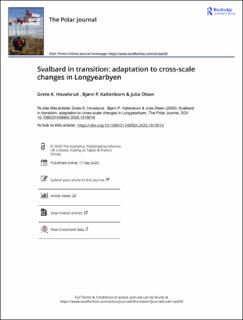| dc.contributor.author | Hovelsrud, Grete Kaare | |
| dc.contributor.author | Kaltenborn, Bjørn Petter | |
| dc.contributor.author | Olsen, Julia | |
| dc.date.accessioned | 2020-09-29T10:18:53Z | |
| dc.date.available | 2020-09-29T10:18:53Z | |
| dc.date.created | 2020-09-21T22:54:42Z | |
| dc.date.issued | 2020 | |
| dc.identifier.citation | Hovelsrud, G. K., Kaltenborn, B. P. & Olsen, J. (2020). Svalbard in transition: adaptation to cross-scale changes in Longyearbyen. The Polar Journal. doi: | en_US |
| dc.identifier.issn | 2154-8978 | |
| dc.identifier.uri | https://hdl.handle.net/11250/2680230 | |
| dc.description.abstract | The backdrop for this study is the Norwegian national Svalbard policy, with long-term goals to transition Svalbard into a sustainable future without coal and to maintain Norwegian presence. Tourism, education and research are the three economic pillars. This transition affects the tourism industry, spatial planners, environmental officials, local politicians, port authorities and research community in Longyearbyen. We apply an adaptation framework and a community-based approach to analyse the multiple layers of change identified by key stakeholders: climate change, national policy and increasing tourism. Based on semi-structured interviews with stakeholders in Longyearbyen and document review we analysed the adaptation strategies and measures to address the challenges and opportunities from the economic transition sectors, climate change impacts, national Svalbard policies and increasing tourism activities. Adaptation dilemmas emerge for Longyearbyen: 1) increased tourism is a national goal while strict environmental management restricts its potential tourism operators, and 2) climate change creates hazardous conditions which require the local spatial planners to develop new safe housing areas, but the strict environmental protection limits the action space. A tension is therefore emerging between the national policy context (The Svalbard Treaty, The Svalbard Act, The Environmental Protection Act) which governs development and local adaptation options to address climate change impacts and increasing tourism. Longyearbyen; Svalbard; national policies; economic transition; climate change; adaptation | en_US |
| dc.language.iso | eng | en_US |
| dc.publisher | Routledge | en_US |
| dc.rights | Attribution-NonCommercial-NoDerivatives 4.0 Internasjonal | * |
| dc.rights.uri | http://creativecommons.org/licenses/by-nc-nd/4.0/deed.no | * |
| dc.subject | Turisme | en_US |
| dc.subject | Tourism | en_US |
| dc.title | Svalbard in transition : adaptation to cross-scale changes in Longyearbyen | en_US |
| dc.type | Peer reviewed | en_US |
| dc.type | Journal article | en_US |
| dc.description.version | publishedVersion | en_US |
| dc.rights.holder | © 2020 The Author(s) | en_US |
| dc.subject.nsi | VDP::Samfunnsgeografi: 290 | en_US |
| dc.subject.nsi | VDP::Human geography: 290 | en_US |
| dc.source.pagenumber | 23 | en_US |
| dc.source.journal | The Polar Journal | en_US |
| dc.identifier.doi | 10.1080/2154896X.2020.1819016 | |
| dc.identifier.cristin | 1831925 | |
| dc.relation.project | The Research Council of Norway: 255783 | en_US |
| dc.description.localcode | Paid Open Access | en_US |

